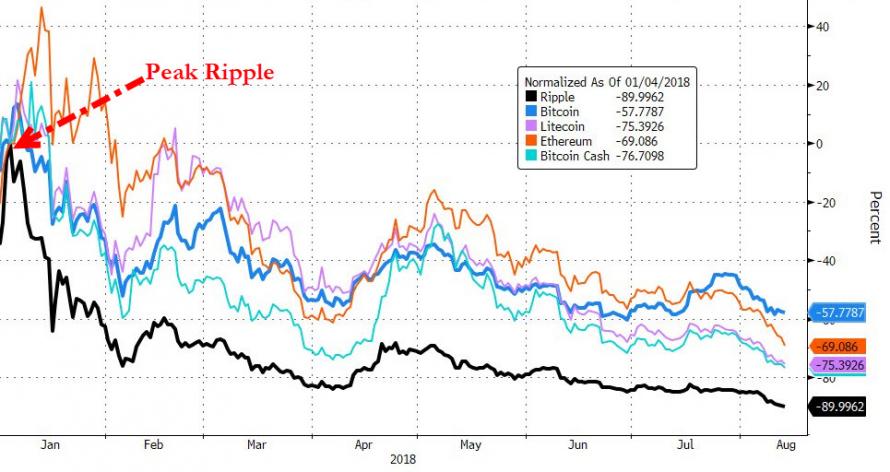To quote the bard, in a manner of speaking: Bubble, bubble, boil … then trouble. Before the Macbeth purists rankle, we’re talking about cryptocurrencies — where drama is underway, so a bit of poetic license is alright.
A series of charts that have been making rounds on the web — first by Mike Shedlock via MishTalk, then picked up by ZeroHedge — show just how far we have come, both up and down, in a world where speculation has reigned, but fundamentals may be ultimately winning out.
Those fundamentals? They aren’t pretty. But first, a picture is worth a thousand words, per Shedlock.

The Peaks, Once, And Now The Valleys
The peaks seem long ago and far away. The valleys? We’re in them right now. The starkest performers are Ripple, Litecoin and Ethereum — down roughly 90 percent, 75 percent and 69 percent from peak levels.
The best performer over the same time frame? Bitcoin: the marquee name, the shorthand for the cryptocurrency space, the 800-pound gorilla in a barrel full of monkeys (and there’s little fun to be had in this barrel right now). In the land of the blind, so to speak, the one-eyed man is king. And here, bitcoin stands out because it is down a relatively paltry 57 percent.
Advertisement: Scroll to Continue
It’s no secret that the crypto realm has been dominated by excitement, speculation and holders who get in quick and get out quicker. Lack of liquidity doesn’t help. Consider the fact that some of these smaller cryptos have market caps that skew to the billion-dollar level or much lower, which means that pricing action may be occurring with relatively wide gaps between bid and asks, or back and forth among the same players. Bitcoin’s market cap is comparatively massive, at a bit less than $200 billion.
As the charts from Shedlock and some others show, the altcoins (alternatives to bitcoin) have shown to be in freefall more than bitcoin. In fact, as CNBC noted Tuesday (Aug. 14), XRP and Ethereum both dropped more than 12 percent on the day. Want a sense of scale and scope of panic? The entire sector lost about $19 billion in a day.
Global trading — always on somewhere — can be a boon, until it’s not. A stampede can gather steam. Thus: Cryptocurrencies are down 69 percent this year to date.
More on that in a minute. Bitcoin stands out as special case in crypto land because, once in a while, a floor comes in to support the price (for a bit).
Some Fundamentals
Bitcoin has some headlines — or some expectation, at least — that use cases may be emerging. The use cases are a bit limited, but, still, they engender some optimism.
After all, news came at the beginning of the month that Intercontinental Exchange, Microsoft and Starbucks would collaborate on a digital asset platform. No, it didn’t, doesn’t and may never mean that one could buy lattes directly with bitcoin. However, collaboration of such heavy hitters would presage Bakkt’s debut — an exchange where bitcoin can be exchanged into fiat to buy assets. A few extra steps in the mix … but commerce is commerce. Maybe.
Contrast that with the fact that any number of initiatives have come and gone, or been delayed, that would give the entire crypto sphere (especially the altcoins) some luster or legitimacy.
This is referring to the fact that the U.S. Securities and Exchange (SEC) has stated that it would not (yet) allow the launch of a cryptocurrency exchange-traded funds (ETF). That would have been a boost to liquidity, too. As CNBC noted, too, another ETF plan (via Cameron and Tyler Winklevoss) was shot down last month.
Oh, and along the way, we’ve seen the debate rage on over whether or not cryptos are securities — a debate that may not have the denouement that some want. Should regulatory agencies (especially in the U.S.) say that XRP is a security, for example, then tax and regulatory implications will be significant. Initial coin offerings (ICOs) are viewed with skepticism here and abroad — and, by the way, SEC Chairman Jay Clayton said that “every ICO” he has seen is a security — amid cases of real/alleged fraud and glitches. Lawsuits? They’re there, too.
These are not one-off events. They speak to the very rules of existence: the whys, whens and hows of cryptocurrencies. None of them seem particularly settled, which leaves once-sanguine traders unsettled.
More Fundamentals
The Shedlock discussion points to a number of fundamental issues that show the economics of cryptos and, most visibly, altcoins leave a lot to be desired. Specifically, the economics of “mining” cryptos have deteriorated to the point where some computer-intense work is just not worth it when it comes to creating altcoins (Ethereum among them).
The inputs of mining — spanning graphics cards and electricity, among other things — are not exactly inconsiderable, and when market prices drop below costs of creation, the whole shebang goes … bang.
Fundamental Truths (Of Physics And Speculation)
There’s a law in physics stating that objects in uniform motion will remain in that state of motion, until an external force comes along to alter that path.
We posit that there is not much in the way of fundamentals that might change the downward trend of the altcoins, and maybe even bitcoin. Markets evolve, somehow and eventually. It may be the case that bitcoin will eventually become more than a bit player, or that utility tokens find some utility.
To quote the bard again, perhaps it’s a case of sound and fury signifying … not a heck of a lot.
But right now, we are in shakeout mode. What came first, and was biggest and strongest, may not always survive. Just ask the dinosaurs.





